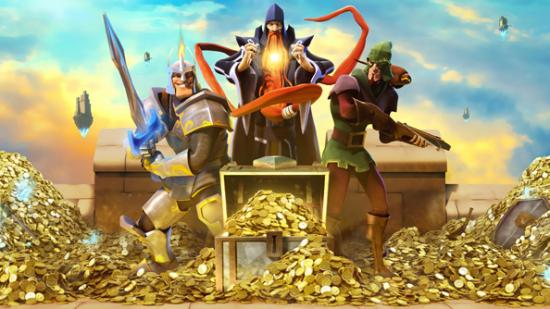The Mighty Quest for Epic Loot is out now; check out our Mighty Quest for Epic Loot review.
Of all the nice people invited to a dank Parisian dungeon (half converted, weirdly, into a nightclub by the addition of some velvet drapes, a strobe light and decks) to play The Mighty Quest for Epic Loot, I was the only person to find some actual epic loot. It was a rare and unique crossbow, Bowgart’s Crossbow, and it fell out of a witch when I shot her in the face with my regular crossbow. There was a 0.3% chance of me finding loot of this calibre, the excited developer informed me, which made me feel very lucky indeed. Later I’d see a dog with two rats riding on its back. It was a good day.
The Mighty Quest for Epic Loot is Ubisoft’s hyper-irreverent, colourful free-to-play dungeon crawler. It’s a Diablo clone in which you play a cartoonish hero, hacking and slashing through player-created castles in search of the most astute loot, endeavouring to reach the level’s grand treasure room before the short timer expires, battling crowds of bloodless enemies and PG boss characters and dodging traps and quipping.
But Mighty Quest also takes heaps of welcome cues from Dungeon Keeper. When you’re not infiltrating dungeons you spend your time and resources constructing a personal fortress of your own to thwart would be looters. Successful raids on opponents’ castles reward you with experience points, loot and gold. That currency can be pumped back into your character to purchase better weapons or gear, or it can be used to improve your castle and fend off ever more attackers. Levelling up gives you access to better stuff for both your hero and your castle, unlocking skills and gear for the former and better traps and monsters for the latter.
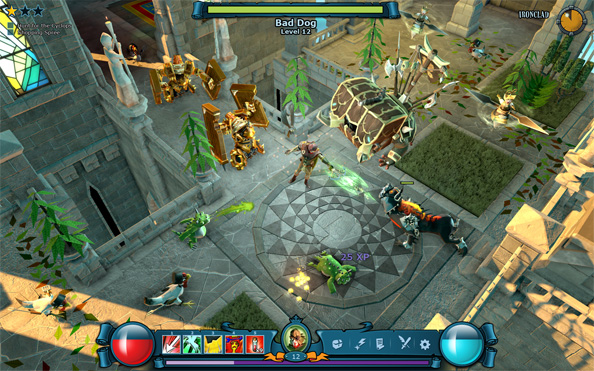
The worry is that one side would be more accomplished, better developed than the other, but Ubisoft have been canny in keeping both modes intrinsically attached to one another. Your castle generates cash, for a start, and its drag and drop editing interface means it can be improved in tedium-free minutes. You’re constantly notified of attacks on your fortress both failed and successful, and at any time you can watch replays of these incursions in order to refine and adapt the design of your fortress. Depending on their efficacy, mobs in your castle produce stacks of coins that you can collect in the castle editing mode. So the better you are at simply maintaining a basic defence, the stronger and better supported the attacking force of your hero will be.
So the two modes are in some sort of tandem. Though the dynamics of Mighty Quest seem wildly malleable as development progresses. We played an artificially hyperactive version of the game in which our castles were almost always open to attacks from other players — in the game proper, Ubisoft intend to place a 30 minute protective cooldown on besieged castles — so the effectiveness of trap layouts and monster placements were almost immediately made apparent by how quickly our coffers were being emptied by treasure swiping heroes.
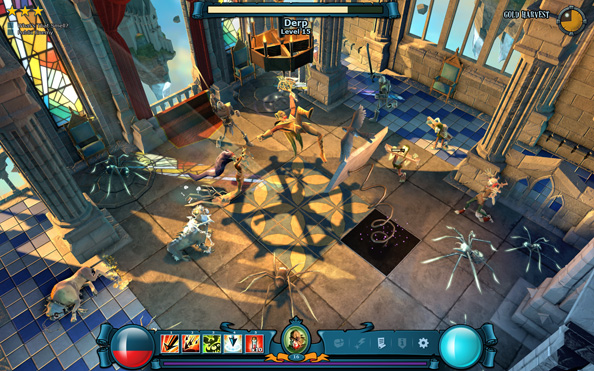
If there is a failing in the defence mode of the game, it’s perhaps in how few options are available in the design of your castle. The basic set of creatures and traps available in the early game include an interesting and varied thematic smattering of angry dogs, chickens, skeletons, ghosts, gremlins and banshees, each with their own traits and abilities, while traps tend to involve spikes and fire turrets, springboards that will propel adventurers into danger, and hamster-powered, bladed wheels. The dogs can howl to summon assistance, melee-heavy skeletons are best picked off at a distance, some enemies can poison, others twirl around the room dodging your attacks, another can resurrect and heal its allies.
However, the intelligent interface won’t allow you to combine certain traps in a way that would be unfair to the player attempting to traverse them. You can’t place a springboard in such a way that it lands on another springboard, or flings an adventurer into the abyss, and once you know what a springboard tile looks like it’s simple, as an adventurer, to avoid them. Exceptionally clever dungeon designs are compromised by the requirement that human players must have fun playing them. You can, with a sufficiently levelled up castle, create multiple routes which could delay the adventurer and run down the clock, locking the main treasure room and denying them victory, but we didn’t get to the play about with castle design at that level.
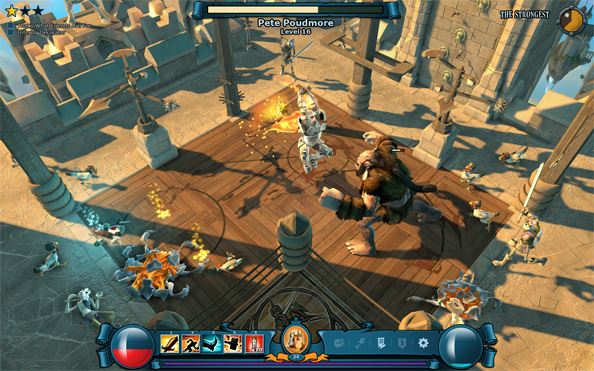
Actually raiding castles involved taking one of two classes of hero, an archer or a knight, and clicking things until they were dead. Mighty Quest’s hacking feels meatily kinetic, not to the degree of the hardy clobbering of Diablo 3, but still to a satisfyingly, physical level. Playing as an archer involves a lot of kiting — running away from enemies while stopping every now and then to fire a cowardly volley of arrows — while the knight is staunch enough to wade into crowds and use area of effect sword swings, directional charges and space-creating boot kicks. The archer’s hawk is eminently useful in prescribing the conditions of a fight before it takes place: the bird can stun powerful enemies while you pick off minions, or inflict a number of other status altering effects. Many of that class’s skills are in fact improvements to the hawk.
Beyond the clicks, there are some familiar ARPG tenets in play. Loot comes with the usual +4s to this and that, as well as increases in magic and gold find, that is, the likelihood of you finding better magic gear and cash. There’s a potion you can purchase to boost your magic find for 30 minutes of play, which anybody half-serious about playing properly will probably want to maintain a constant supply of. It’s here, in the commodity store, that Mighty Quest’s dealbreaking free-to-play feature will likely arise. Potions and powerful gear can be bought using coins or gems, the latter being the paid-for currency of the game world. You can find gems through normal play, but obviously not nearly as quickly as you would by opening your wallet.
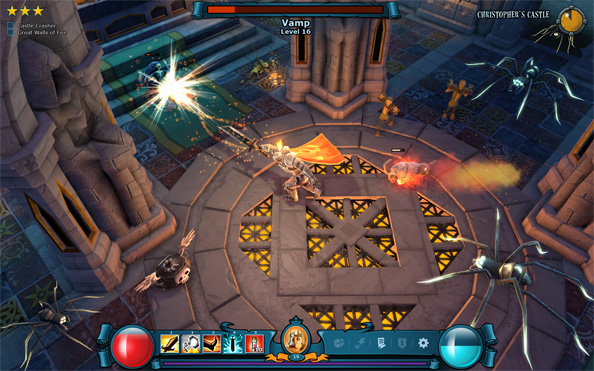
But even Ubisoft still don’t know how this exchange rate will be tuned. They haven’t decided which parts of the attacking and defending halves of the game will be most buoyed by an injection of microtransactions, whether players should be able to unlock everything with a single payment, or even whether Mighty Quest will be free to play at all (laughably unlikely in my opinion, though the producer on hand did suggest it). They’re turning to their players, their forums and their beta testers to inform their design choices in this respect, with their noble goal being to create a free to play game that isn’t absolutely cynical and apparently unfair to anybody not utterly Stockholm syndromed by the thing.
They have the fundamentals firmly in place: the good humour and dopamine-triggering click-happy hackenslashing. I know this because I actually cared when I found my epic loot, confidently leaning back in my chair like a big self-satisfied bastard to see if anybody else had noticed my luck, before using it to smash through every one my peers’ castles and climb up our leaderboard. What’s important now are the grand overhauls and surgical tweaks Ubisoft will make to the game’s microtransaction-fuelled ecosystem. With The Mighty Quest for Epic Loot, I honestly think Ubisoft have a shot at creating the first free to play game to challenge the dirtiness of those three words.
And here are the rats on a dog, in case you think I made that up.

